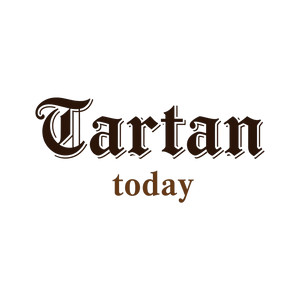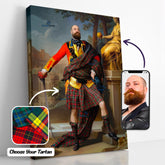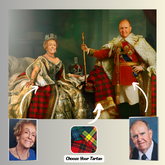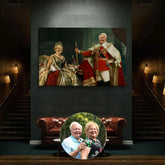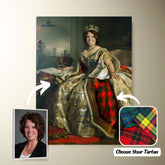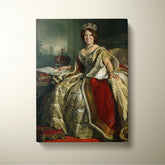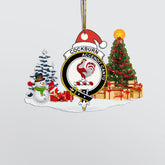-
Personalized Clan Cockburn Ancient Tartan Bagpipe Ornament with Custom Name – Scottish Christmas Tree Decoration UE23
Personalized Clan Cockburn Ancient Tartan Bagpipe Ornament with Custom Name – Scottish Christmas Tree Decoration UE23Celebrate your Scottish heritage with this unique wood & acrylic tartan ornament. Perfect as a personalized Christmas decoration or a meaningful gift for friends and relatives on special occasions...- From $19.99 USD
$25.99 USD- From $19.99 USD
- Unit price
- per
Save $6.00 -
Personalized Clan Cockburn Modern Tartan Bagpipe Ornament with Custom Name – Scottish Christmas Tree Decoration BO44
Personalized Clan Cockburn Modern Tartan Bagpipe Ornament with Custom Name – Scottish Christmas Tree Decoration BO44Celebrate your Scottish heritage with this unique wood & acrylic tartan ornament. Perfect as a personalized Christmas decoration or a meaningful gift for friends and relatives on special occasions...- From $19.99 USD
$25.99 USD- From $19.99 USD
- Unit price
- per
Save $6.00 -
Personalized Clan MacLaine of LochBuie (Cockburn) (MacLaine of LochBuie) Weathered Tartan Santa Ornament – Custom Acrylic Christmas Decoration KE99 - MacLaine
Personalized Clan MacLaine of LochBuie (Cockburn) (MacLaine of LochBuie) Weathered Tartan Ornament – Custom Acrylic Christmas Decoration KE99Celebrate your Scottish heritage with this unique wood & acrylic tartan ornament. Perfect as a personalized Christmas decoration or a meaningful gift for friends and relatives on...- From $19.99 USD
- From $19.99 USD
- Unit price
- per
-
MacLaine
-
Clan Cockburn Crest Tartan Acrylic Christmas Ornament LE96 - Cockburn Tartan
Clan Cockburn Crest Tartan Acrylic Christmas Ornament LE96“Decorating the house” may be one of the most exciting tasks jotted down on your to-do list when the holiday season approaches. Yet, since shabby, dull-looking pieces of decor infest the marketplace, finding real gems that endure...- From $21.25 USD
- From $21.25 USD
- Unit price
- per
-
Cockburn Tartan
-
Clan Cockburn Modern Tartan Crest Tumbler HT92 - Cockburn Modern Tartan Clan
Cockburn Modern Tartan Clan Crest Tumbler HT92 Product Detail: Cockburn Modern Tartan Crest Tumbler Introducing our Tartan Tumbler, a perfect companion for your daily hydration needs. This mobile tumbler comes with a slide lid and an ideal size, providing convenience as you enjoy your...- From $45.99 USD
- From $45.99 USD
- Unit price
- per
-
Cockburn Modern Tartan Clan
-
Personalized Clan Cockburn Modern Tartan Drummer Ornament with Custom Name – Scottish Christmas Tree Decoration QH49
Personalized Clan Cockburn Modern Tartan Drummer Ornament with Custom Name – Scottish Christmas Tree Decoration QH49Celebrate your Scottish heritage with this unique wood & acrylic tartan ornament. Perfect as a personalized Christmas decoration or a meaningful gift for friends and relatives on special occasions...- From $19.99 USD
$25.99 USD- From $19.99 USD
- Unit price
- per
Save $6.00 -
Personalized Clan Cockburn Ancient Tartan Drummer Ornament with Custom Name – Scottish Christmas Tree Decoration KJ95
Personalized Clan Cockburn Ancient Tartan Drummer Ornament with Custom Name – Scottish Christmas Tree Decoration KJ95Celebrate your Scottish heritage with this unique wood & acrylic tartan ornament. Perfect as a personalized Christmas decoration or a meaningful gift for friends and relatives on special occasions...- From $19.99 USD
$25.99 USD- From $19.99 USD
- Unit price
- per
Save $6.00 -
Personalized Clan MacLaine of Lochbuie (Cockburn) Reproduction Tartan Bagpipe Ornament with Custom Name – Scottish Christmas Tree Decoration RP22
Personalized Clan MacLaine of Lochbuie (Cockburn) Reproduction Tartan Bagpipe Ornament with Custom Name – Scottish Christmas Tree Decoration RP22Celebrate your Scottish heritage with this unique wood & acrylic tartan ornament. Perfect as a personalized Christmas decoration or a meaningful gift for friends and relatives...- From $19.99 USD
$25.99 USD- From $19.99 USD
- Unit price
- per
Save $6.00 -
Personalized Clan MacLaine of Lochbuie (Cockburn) Muted Tartan Bagpipe Ornament with Custom Name – Scottish Christmas Tree Decoration MT14
Personalized Clan MacLaine of Lochbuie (Cockburn) Muted Tartan Bagpipe Ornament with Custom Name – Scottish Christmas Tree Decoration MT14Celebrate your Scottish heritage with this unique wood & acrylic tartan ornament. Perfect as a personalized Christmas decoration or a meaningful gift for friends and relatives...- From $19.99 USD
$25.99 USD- From $19.99 USD
- Unit price
- per
Save $6.00 -
Personalized Clan MacLaine of Lochbuie (Cockburn) Modern Tartan Bagpipe Ornament with Custom Name – Scottish Christmas Tree Decoration PK51
Personalized Clan MacLaine of Lochbuie (Cockburn) Modern Tartan Bagpipe Ornament with Custom Name – Scottish Christmas Tree Decoration PK51Celebrate your Scottish heritage with this unique wood & acrylic tartan ornament. Perfect as a personalized Christmas decoration or a meaningful gift for friends and relatives...- From $19.99 USD
$25.99 USD- From $19.99 USD
- Unit price
- per
Save $6.00 -
Personalized Clan MacLaine of Lochbuie (Cockburn) Ancient Tartan Bagpipe Ornament with Custom Name – Scottish Christmas Tree Decoration ZY37
Personalized Clan MacLaine of Lochbuie (Cockburn) Ancient Tartan Bagpipe Ornament with Custom Name – Scottish Christmas Tree Decoration ZY37Celebrate your Scottish heritage with this unique wood & acrylic tartan ornament. Perfect as a personalized Christmas decoration or a meaningful gift for friends and relatives...- From $19.99 USD
$25.99 USD- From $19.99 USD
- Unit price
- per
Save $6.00 -
Personalized Clan Cockburn Reproduction Tartan Bagpipe Ornament with Custom Name – Scottish Christmas Tree Decoration JG22
Personalized Clan Cockburn Reproduction Tartan Bagpipe Ornament with Custom Name – Scottish Christmas Tree Decoration JG22Celebrate your Scottish heritage with this unique wood & acrylic tartan ornament. Perfect as a personalized Christmas decoration or a meaningful gift for friends and relatives on special occasions...- From $19.99 USD
$25.99 USD- From $19.99 USD
- Unit price
- per
Save $6.00 -
Personalized Clan Cockburn old pattern Reproduction Tartan Bagpipe Ornament with Custom Name – Scottish Christmas Tree Decoration UY81
Personalized Clan Cockburn old pattern Reproduction Tartan Bagpipe Ornament with Custom Name – Scottish Christmas Tree Decoration UY81Celebrate your Scottish heritage with this unique wood & acrylic tartan ornament. Perfect as a personalized Christmas decoration or a meaningful gift for friends and relatives on...- From $19.99 USD
$25.99 USD- From $19.99 USD
- Unit price
- per
Save $6.00 -
Personalized Clan Cockburn old pattern Modern Tartan Bagpipe Ornament with Custom Name – Scottish Christmas Tree Decoration ZS92
Personalized Clan Cockburn old pattern Modern Tartan Bagpipe Ornament with Custom Name – Scottish Christmas Tree Decoration ZS92Celebrate your Scottish heritage with this unique wood & acrylic tartan ornament. Perfect as a personalized Christmas decoration or a meaningful gift for friends and relatives on...- From $19.99 USD
$25.99 USD- From $19.99 USD
- Unit price
- per
Save $6.00 -
Personalized Clan Cockburn old pattern Ancient Tartan Bagpipe Ornament with Custom Name – Scottish Christmas Tree Decoration VH67
Personalized Clan Cockburn old pattern Ancient Tartan Bagpipe Ornament with Custom Name – Scottish Christmas Tree Decoration VH67Celebrate your Scottish heritage with this unique wood & acrylic tartan ornament. Perfect as a personalized Christmas decoration or a meaningful gift for friends and relatives on...- From $19.99 USD
$25.99 USD- From $19.99 USD
- Unit price
- per
Save $6.00 -
Personalized Clan Cockburn of Ormiston Dress Reproduction Tartan Bagpipe Ornament with Custom Name – Scottish Christmas Tree Decoration EF33
Personalized Clan Cockburn of Ormiston Dress Reproduction Tartan Bagpipe Ornament with Custom Name – Scottish Christmas Tree Decoration EF33Celebrate your Scottish heritage with this unique wood & acrylic tartan ornament. Perfect as a personalized Christmas decoration or a meaningful gift for friends and relatives...- From $19.99 USD
$25.99 USD- From $19.99 USD
- Unit price
- per
Save $6.00 -
Personalized Clan Cockburn of Ormiston Dress Modern Tartan Bagpipe Ornament with Custom Name – Scottish Christmas Tree Decoration TO31
Personalized Clan Cockburn of Ormiston Dress Modern Tartan Bagpipe Ornament with Custom Name – Scottish Christmas Tree Decoration TO31Celebrate your Scottish heritage with this unique wood & acrylic tartan ornament. Perfect as a personalized Christmas decoration or a meaningful gift for friends and relatives...- From $19.99 USD
$25.99 USD- From $19.99 USD
- Unit price
- per
Save $6.00 -
Personalized Clan Cockburn of Ormiston Dress Ancient Tartan Bagpipe Ornament with Custom Name – Scottish Christmas Tree Decoration AZ59
Personalized Clan Cockburn of Ormiston Dress Ancient Tartan Bagpipe Ornament with Custom Name – Scottish Christmas Tree Decoration AZ59Celebrate your Scottish heritage with this unique wood & acrylic tartan ornament. Perfect as a personalized Christmas decoration or a meaningful gift for friends and relatives...- From $19.99 USD
$25.99 USD- From $19.99 USD
- Unit price
- per
Save $6.00 -
Personalized Clan Cockburn Muted Tartan Bagpipe Ornament with Custom Name – Scottish Christmas Tree Decoration KV54
Personalized Clan Cockburn Muted Tartan Bagpipe Ornament with Custom Name – Scottish Christmas Tree Decoration KV54Celebrate your Scottish heritage with this unique wood & acrylic tartan ornament. Perfect as a personalized Christmas decoration or a meaningful gift for friends and relatives on special occasions...- From $19.99 USD
$25.99 USD- From $19.99 USD
- Unit price
- per
Save $6.00 -
Personalized Clan Cockburn Brown Reproduction Tartan Bagpipe Ornament with Custom Name – Scottish Christmas Tree Decoration JA25
Personalized Clan Cockburn Brown Reproduction Tartan Bagpipe Ornament with Custom Name – Scottish Christmas Tree Decoration JA25Celebrate your Scottish heritage with this unique wood & acrylic tartan ornament. Perfect as a personalized Christmas decoration or a meaningful gift for friends and relatives on special...- From $19.99 USD
$25.99 USD- From $19.99 USD
- Unit price
- per
Save $6.00
Ex: Your Tartan + Product
Popular Products
Turn Me Royal Personalized Portrait from Your Photo, Custom Tartan. Custom Canvas Wall Art as Gift for Men
- From $32.45 USD
- From $32.45 USD
- Unit price
- / per
Royalty Couple Personalized Portrait from Your Photo, Custom Tartan. Custom Canvas Wall Art
- From $47.45 USD
- From $47.45 USD
- Unit price
- / per
The Queen Personalized Portrait from Your Photo, Custom Tartan. Custom Canvas Wall Art as Gift for Women
- From $32.45 USD
- From $32.45 USD
- Unit price
- / per
Which Clan Are You From?
- Apron
- Cockburn
- Cockburn (Coburn) Ancient
- Cockburn (Coburn) Modern
- Cockburn (Coburn) Weathered
- Cockburn (Old Pattern)
- Cockburn 01
- Cockburn 02
- Cockburn Ancient
- Cockburn Ancient Tartan
- Cockburn Blue
- Cockburn Brown Ancient
- Cockburn Brown Modern
- Cockburn Brown Reproduction
- Cockburn clan
- Cockburn Modern
- Cockburn Modern Tartan
- Cockburn Muted
- Cockburn of Ormiston Dress
- Cockburn of Ormiston Dress Ancient
- Cockburn of Ormiston Dress Modern
- Cockburn of Ormiston Dress Reproduction
- Cockburn Old
- Cockburn old pattern Ancient
- Cockburn old pattern Modern
- Cockburn old pattern Reproduction
- Cockburn Reproduction
- Cockburn tartan
- Cockburn Tartan Clan
- Cockburn tartanPillow Cover
- MacAlister
- MacAlister Cockburn
- MacLaine of LochBuie (Cockburn) (MacLaine of LochBuie) Ancient
- MacLaine of LochBuie (Cockburn) (MacLaine of LochBuie) Modern
- MacLaine of LochBuie (Cockburn) (MacLaine of LochBuie) Weathered
- MacLaine of LochBuie (Cockburn) (MacLaine) Ancient
- MacLaine of LochBuie (Cockburn) (MacLaine) Modern
- MacLaine of LochBuie (Cockburn) (MacLaine) Weathered
- MacLaine of Lochbuie (Cockburn) Ancient
- MacLaine of Lochbuie (Cockburn) Modern
- MacLaine of Lochbuie (Cockburn) Muted
- MacLaine of Lochbuie (Cockburn) Reproduction
- Scott
List Of Tartan
-
Clan A
- Abercrombie Tartan
- Aberdeen Tartan
- Abernethy Tartan
- Adair Tartan
- Adam Tartan
- Ayrshire Tartan
- Agnew Tartan
- Aikenhead Tartan
- Ainslie Tartan
- Aiton Tartan
- Allan Tartan
- Alexander Tartan
- Allardice Tartan
- Allison Tartan
- Anderson Tartan
- Angus Tartan
- Anstruther Tartan
- Arbuthnot Tartan
- Armstrong Tartan
- Arnott Tartan
- Auchinleck Tartan
- Ayrshire Tartan
-
Clan B
- Baillie Tartan
- Bain Tartan
- Baird Tartan
- Balfour Tartan
- Bannatyne Tartan
- Bannerman Tartan
- Barclay Tartan
- Baxter Tartan
- Beaton Tartan
- Bell Tartan
- Belshes Tartan
- Bethune Tartan
- Beveridge Tartan
- Binning Tartan
- Bisset Tartan
- Blackadder Tartan
- Blackstock Tartan
- Black Watch Tartan
- Blair Tartan
- Blane Tartan
- Blyth Tartan
- Borthwick Tartan
- Boswell Tartan
- Bowie Tartan
- Boyd Tartan
- Boyle Tartan
- Brisbane Tartan
- Brodie Tartan
- Brown/ Broun Tartan
- Bruce Tartan
- Buccleuch Tartan
- Buchan Tartan
- Buchanan Tartan
- Burnett Tartan
- Burns Tartan
- Butter Tartan
- Byres Tartan
-
Clan C
- Cairns Tartan
- Calder Tartan
- Callander Tartan
- Cameron Tartan
- Campbell Tartan
- Campbell of Breadalbane Tartan
- Campbell of Cawdor Tartan
- Carmichael Tartan
- Carnegie Tartan
- Carruthers Tartan
- Cathcart Tartan
- Chalmers Tartan
- Charteris Tartan
- Chattan Tartan
- Cheyne Tartan
- Chisholm Tartan
- Christie Tartan
- Clark Tartan
- Clelland Tartan
- Clephan Tartan
- Clergy Tartan
- Cochrane Tartan
- Cockburn Tartan
- Colquhoun Tartan
- Colville Tartan
- Cooper Tartan
- Couper Tartan
- Craig Tartan
- Cranstoun Tartan
- Crawford Tartan
- Crichton Tartan
- Crief District Tartan
- Crosbie Tartan
- Cumming Tartan
- Cunningham Tartan
- Currie Tartan
- Clan D
- Clan E
- Clan F
- Clan G
- Clan H
- Clan I
- Clan J
- Clan K
- Clan L
-
Clan M
- Maitland Tartan
- Malcolm Tartan
- Mar Tartan
- Marjoribanks Tartan
- Maxtone Tartan
- Matheson Tartan
- Maule Tartan
- Maxwell Tartan
- Meldrum Tartan
- Melville Tartan
- Menzies Tartan
- Mercer Tartan
- Middleton Tartan
- Moffat Tartan
- Moncrieffe Tartan
- Montgomery Tartan
- Monypenny Tartan
- Moncreiffe Tartan
- Monteith Tartan
- Morrison Tartan
- Mouat Tartan
- Moubray Tartan
- Mow Tartan
- Muir_More Tartan
- Muirhead Tartan
- Munro Tartan
- Murray Tartan
- Murray of Atholl Tartan
-
Clan Mc/Mac
- MacAlister Tartan
- MacArthur Tartan
- MacAlpine Tartan
- MacAulay Tartan
- MacBain Tartan
- MacBean Tartan
- MacBeth Tartan
- MacCallum Tartan
- MacCraig Tartan
- MacColl Tartan
- MacCorquodale Tartan
- MacDiarmid Tartan
- MacDonald Tartan
- MacDonald of Clanranald Tartan
- MacDonald of Sleat Tartan
- MacDonnell of Glengarry Tartan
- MacDonnell of Keppoch Tartan
- MacDougall Tartan
- MacDowall Tartan
- MacDuff Tartan
- MacEwen_MacEwan Tartan
- MacEdward Tartan
- MacFarlane Tartan
- MacGill Tartan
- MacGillivray Tartan
- MacGregor Tartan
- MacGowan (McGowan) Tartan
- MacHardy Tartan
- MacIan Tartan
- MacInnes Tartan
- MacIntyre Tartan
- MacKay Tartan
- MacKillop Tartan
- MacKellar Tartan
- Mackinlay Tartan
- MacKenzie Tartan
- Mackie Tartan
- MacKinnon Tartan
- MacKintosh / MacIntosh Tartan
- MacLeod Tartan
- MacMillan Tartan
- MacNab Tartan
- MacNaughton Tartan
- MacNeil / MacNeill Tartan
- MacNeil of Colonsay Tartan
- MacNicol Tartan
- MacPhail Tartan
- MacPhee_MacFie Tartan
- MacPherson Tartan
- MacQuarrie Tartan
- MacQueen Tartan
- MacRae Tartan
- MacRow Tartan
- MacSporran Tartan
- MacTaggart Tartan
- MacTavish Tartan
- MacThomas Tartan
- McCorquodale Tartan
- McCulloch Tartan
- McFadzen Tartan
- McGeachie Tartan
- McIver Tartan
- McKerrell Tartan
- Clan N
- Clan O
- Clan P
- Clan R
-
Clan S
- Sandilands Tartan
- Scott Tartan
- Scrymgeour Tartan
- Selkirk Tartan
- Sempill Tartan
- Seton Tartan
- Shaw Tartan
- Shepherd Tartan
- Sinclair Tartan
- Skene Tartan
- Skirving Tartan
- Smith Tartan
- Somerville Tartan
- Spalding Tartan
- Spens Tartan
- Spottiswood Tartan
- Stevenson Tartan
- Stewart Tartan
- Stewart of Appin Tartan
- Stirling Tartan
- Strachan Tartan
- Straiton Tartan
- Strange Tartan
- Strathclyde District Tartan
- Stuart of Bute Tartan
- Sutherland Tartan
- Swinton Tartan
- Clan T
- Clan U W Y
- Request Your Clan
Clan Cockburn (Cockburn Tartan)
1. About Clan Cockburn (Cockburn Tartan)
2. Cockburn Clan History (Cockburn Tartan)
Regarding the origin of this surname, there are various theories. One posits a connection to a location near Duns in Berwickshire, while another contends that it derives from the old Scots word "gowk," which means "cuckoo," and is related to Cukooburn in Roxburghshire.
The fact that the crest is a cockerel might appear odd in light of this, but it can be explained by a practice known as "canting," in which a person's surname is occasionally punned into the design of their crest.
Peres de Cockburne and Thomas de Cockburn of Roxburgshire are two of the Cockburns whose signatures appear on the Ragman Roll of 1296.
The holdings at Langton in Berwickshire belonged to Sir William de Vipont, who fought at the Battle of Bannockburn but was killed, and Sir Alexander de Cockburn acquired them after marrying the Vipont's daughter.
The Great Seal of Scotland was given to "Alexander Cockburn de Langton" in 1390. He made his son, who bears his name, the hereditary great usher of Scotland. This was established for the Barony of Langton in a charter issued by James IV in 1504.
The position was usurped, according to Balfour's Annals, by John, Earl of Wigtown.
The matter was referred to a committee of parliament, but Langton was so outraged that when the King arrived at parliament, he was met with a frontal protest from Langton, who was then imprisoned in Edinburgh Castle for a day (see top photo).
One of the nobility killed during the Battle of Flodden in 1513 was Sir William Cockburn of Langton, a descendant of Sir Alexander.
The family stuck by the Stuart cause and sided with Mary Queen of Scots, which led to the destruction of Stirling Castle. When a relative was created a Baronet of Nova Scotia in 1671, the principal line sold him their holdings.
The Scottish Enlightenment's leading personality and the legendary Lord Melville's nephew, Lord Cockburn (1779–1854), is one of the notable Cockburns.
The lines to the lament "The Flowers of the Forest" were written by Alison Cockburn (1713–1744), and Admiral Sir George Cockburn (1772–1853) transported Napoleon to exile on the island of St. Helena.
3. Cockburn Clan Tartans
Thought to be a Wilson's of Bannockburn tartan, the Cockburn tartan may have been given its name in honor of General Cockburn, who enjoyed some notoriety in the early 1800s.
'Modern' refers to the dye shades, which are often darker, and 'ancient' alludes to the employment of lighter colored dyes.
Cockburn Modern
Cockburn Ancient
4. Clan Cockburn Crest & Coats of Arms
4.1 Clan Cockburn Crest
Worn by all of the name and ancestry
Crest Description:
A cock crowing, Proper
4.2 Clan Cockburn Coats of Arms
Note on Coats of Arms: A coat of arms is given to an individual under Scottish heraldic law (with the exception of civic or corporate arms). A 'family coat of arms' does not exist.
With the exclusions listed above, the weapons depicted below are personal weapons. The only person authorized to use these weapons is the grantee.
COCKBURN of that Ilk
Argent, three cocks, Gules
Coat of Arms for Richard Cockburn of Clerkington
5. Clan Cockburn Places & People
6. Associated Names
COBURN COGBURN DE COCKBORNE
More information
7. The Origins of the Cockburn Surname
- Discuss the place name near Duns, Berwickshire as a possible origin
- Explore the debate about the Scots word for cuckoo as another possibility
- Provide historical context for the surname's usage and evolution
7.2 Clan Cockburn in the Early Years
- Mention John Kocbrun, a landowner in Fife, ceding lands to the Monastery of Lindores in 1250
- Highlight Thomas de Cokeburn of Roxburgshire rendering homage to Edward I of England in 1296
- Showcase the marriage of Sir Alexander de Cockburn and the acquisition of Langton lands
7.3 Notable Figures in Clan Cockburn's History
Sir Alexander Cockburn de Langton: Keeper of the Great Seal and Hereditary Great Usher
-
Discuss Sir Alexander's appointment as Keeper of the Great Seal of Scotland in 1390
-
Detail the grant of the Barony of Carriden by David II
-
Highlight the dispute over the Hereditary Great Usher office and Cockburn's protest
Sir William Cockburn of Langton: Battle of Flodden and Supporter of Mary Queen of Scots
- Discuss Sir William's involvement in the Battle of Flodden in 1513 and his tragic death
- Explore the Cockburns' support for Mary Queen of Scots and the consequences for their castle at Skirling
- Mention the eventual sale of the barony of Langton and the Nova Scotia baronetcy
Adam Cockburn of Ormiston: Lord Ormiston and Agricultural Improvements
- Highlight Adam Cockburn's role as a Lord Justice Clerk and his creation as Lord Ormiston
- Discuss the achievements of his son, John Cockburn, as an agricultural improver
- Highlight Lord Cockburn's contribution to the Scottish Enlightenment and his famous diary and journal
Alison Cockburn: Prominent Poetess and Social Figure
- Discuss Alison Cockburn's prominence in the Edinburgh social scene
- Mention her contributions as a poetess, including the lyrics for "The Flowers of the Forest"
- Highlight her impact and influence on Scottish culture
Admiral Sir George Cockburn: Escorting Napoleon Bonaparte and First Sea Lord
- Discuss Admiral Sir George Cockburn's role in escorting Napoleon Bonaparte into exile on St Helena
- Highlight his position as First Sea Lord and his important contributions to the Royal Navy
7.4 Landmarks Associated with Clan Cockburn
Cockburnlaw: A Conical Hill in Berwickshire
- Discuss the location and significance of Cockburnlaw in northwest Duns, Berwickshire
- Mention its historical and cultural importance to Clan Cockburn
Cockburnspath Tower: The Inspiration for Sir Walter Scott's "Ravenswood"
- Highlight Cockburnspath Tower's connection to Sir Walter Scott's novel "Bride of Lammermoor"
- Explore the history and features of this notable landmark in Cockburnspath, Berwickshire
Skirling: Former Cockburn Family Holding in Peeblesshire
- Discuss the historical ownership of Skirling by the Cockburn family until 1568
- Mention the significance and relevance of Skirling to Clan Cockburn
Bonally Tower: Home of Lord Cockburn and Present-Day Apartments
- Discuss Bonally Tower's association with Lord Cockburn and its current status as apartments
- Highlight the historical importance of Bonally Tower in Colinton, Edinburgh
Carriden: A Barony Conferred to Sir Alexander Cockburn
- Provide context for the conferred barony of Carriden by David II to Sir Alexander Cockburn
- Mention the significance of Carriden in West Lothian to Clan Cockburn
7.5 Distribution of the Cockburn Surname
- Mention the prevalence of the Cockburn surname in the Scottish Borders, Edinburgh City, and the Lothians
- Highlight specific regions where the surname is most commonly found, including Berwickshire, Peeblesshire, Roxburghshire, Selkirkshire, and parts of Midlothian
7.6 FAQs about Clan Cockburn
7.6.1 What is the significance of the Cockburn tartan?
- Discuss the symbolic importance of the Cockburn tartan to Clan Cockburn
- Provide insight into the design and colors of the tartan
7.6.2 What does the clan crest of Clan Cockburn represent?
- Explain the meaning behind the clan crest featuring a crowing cock
- Elaborate on the symbolism or historical significance of the crest
7.6.3 Who is the most famous member of Clan Cockburn?
- Discuss the contributions and achievements of Lord Cockburn as a Court of Session judge and influential figure of the Scottish Enlightenment
- Mention other notable members, such as Mrs. Cockburn and Admiral Sir George Cockburn
7.6.4 Are there any traditions or celebrations associated with Clan Cockburn?
- Explore any existing traditions, gatherings, or celebrations specific to Clan Cockburn
- Mention any events or activities that honor the clan's heritage and history
7.6.5 Are there any other notable landmarks associated with Clan Cockburn?
- Discuss any additional landmarks or locations associated with Clan Cockburn
- Provide brief information about their historical or cultural significance
7.6.6 How can I learn more about Clan Cockburn and its history?
- Recommend credible sources or references for further research on Clan Cockburn's history and legacy
- Mention any specific books, websites, or organizations dedicated to the clan's history
8. Conclusion
- Recap the main points discussed in the article regarding the rich history and legacy of Clan Cockburn
- Highlight the significance of the Cockburn tartan, clan crest, and notable members
- Encourage readers to continue exploring and learning about Clan Cockburn's fascinating history
- Choosing a selection results in a full page refresh.
